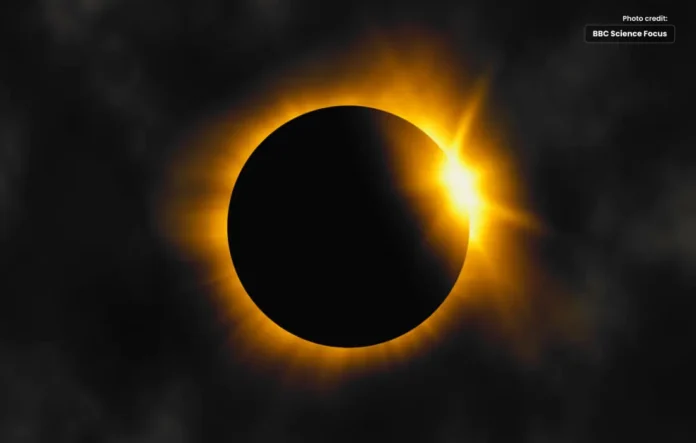Discover and uncover the mysterious event of a total solar eclipse.
The physics underlying these breathtaking occurrences and learn about the celestial mechanics that cause total solar eclipse to occur.
Solving the Enigmas of Total Solar Eclipses: An Enormous Dance of Light and Darkness
See the sky as a wide expanse underneath you, with the sun gently fading as if a cosmic hand were slowly draping a curtain across its blazing surface.
When daylight gives way to an ethereal dusk, the surroundings take on an unsettling color.
Read More Informative Articles in Urdu
When the moon correctly positions itself between the Earth and the sun, a shadow that covers the entire area is cast, causing the birds to go silent and sending shivers down your spine.
One of the most amazing and captivating natural phenomena that exists is the total solar eclipse that you are currently seeing.
We explore the fascinating phenomenon of total solar eclipses in this inquiry, delving into the science underlying these celestial displays and comprehending the complex celestial mechanics that give them life.
The Celestial Bodies’ Dance
Fundamentally, a solar eclipse happens when the moon moves in front of the Earth and the sun, blocking some or all of the sun’s light from our perspective. However, not every solar eclipse is made equally.
The most spectacular of these occurrences is the total solar eclipse, in which the moon precisely lines up with the sun to completely obscure its disk and cast the surrounding area in complete darkness.
The celestial dance of the Earth, moon, and sun is essential knowledge to learn in order to comprehend why complete solar eclipses occur.
The moon orbits Earth in an elliptical pattern, while our planet follows a nearly round course around the sun.
The moon’s orbit is inclined in comparison to Earth’s orbit around the sun, despite the moon’s smaller size, so the three celestial bodies seldom line up exactly.
Optimal Alignment: The Way to Completeness
Only when the moon, Earth, and sun line up in a certain pattern known as a syzygy can there be a total solar eclipse.
When observed from specific points on Earth, the moon is in this uncommon alignment at the exact distance and direction to fully enclose the disk of the sun. It’s common to refer to this occurrence as the “path of totality.”
The totality path is usually only a few dozen miles wide, making it relatively narrow. A partial solar eclipse, in which the moon only covers a section of the sun, is visible to observers outside of this path.
But lucky viewers are treated to the amazing spectacle of a total solar eclipse within the eclipse’s path, where day becomes an otherworldly twilight and the sun’s corona—a halo of plasma around the sun—becomes visible.
The Principles Behind Eclipse Timing
Total solar eclipses are not arbitrary occurrences, despite how rare they are. Because of the Earth’s and moon’s regular motions, they happen with clockwork accuracy.
Due to a combination of gravitational pull and other forces, the lunar orbit around Earth is not stationary; rather, it steadily precesses over time.
Astronomers refer to this precession as the Saros cycle because it causes centuries-long shifts in the dates and places of total solar eclipses.
The Saros cycle, which lasts for around eighteen years and eleven days, determines how often solar and lunar eclipses occur.
Every Saros cycle consists of a sequence of eclipses with comparable attributes, such as totality timing, duration, and geographic course.
Astronomers may forecast the location and timing of future eclipses by utilizing the Saros cycle, which enables fans to schedule their observations years in advance.
Pursuing Shadows
Observing a total solar eclipse is an event of a lifetime for both eclipse enthusiasts and astronomers. A few brief minutes of totality, when the sun’s corona bursts forth in all of its majesty and the surrounding countryside is enveloped in an ethereal glow, may be the culmination of months or even years of preparation.
In search of these heavenly occurrences, eclipse chasers travel the world, frequently enduring inaccessible places and erratic weather to find the ideal viewing site.
Eclipse seekers will travel great distances to see nature’s most spectacular show, from the untamed landscapes of the American West to the frigid depths of Antarctica.
Beyond the Spectacle
Total solar eclipses offer great chances for scientific study in addition to captivating the public with their beauty and mystique. Astronomers may observe the sun’s corona, or outer atmosphere, during totality, which is when the sun’s glare is not as strong.
Scientists can gain additional insight into the temperature, dynamics, and structure of the corona by studying it during eclipses. This observation can help explain basic processes like solar wind acceleration and magnetic field interactions.
Moreover, total solar eclipses offer unique opportunities to study Earth’s ecosystem and environment.
Changes in temperature, humidity, and animal behavior during an eclipse can provide scientists studying atmospheric dynamics and ecology with valuable information.
Citizen scientists contribute to these efforts by recording their views and sharing data through collaborative networks, turning a celestial show into a global scientific endeavor.
Conclusion
Total solar eclipses are among the most spectacular natural events that occur in the enormous fabric of the universe. These occurrences serve as a reminder of the wonders that exist outside the realm of our daily experience, from the exact alignment of celestial bodies to the magnificent beauty of totality.
Total solar eclipses are a powerful reminder of our place in the universe as we continue to unravel its mysteries. These heavenly displays astonish and amaze both seasoned astronomers and novice viewers, kindling a desire for exploration that has no geographical bounds and no age limits.
Also read this: Today Complete Solar Eclipse not Visible in Pakistan




